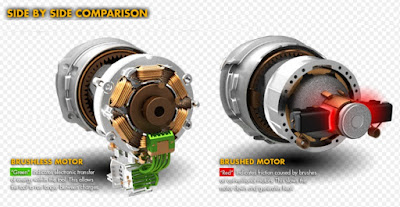Brushes are used in two main types of motors: DC motors and large synchronous motors, called wound-rotor synchronous motors. There is a third case in which brushes was used, the wound-rotor induction motor that has been obsolete for many years. In the DC motor case, the brushes transfer current into the rotor via the commutator. In the AC synchronous motor case, the brushes transfer current into the rotor via slip rings, which conduct current but do not do any sort of switching function, as does a commutator.
The problem with such machines is that the rotor winding inertia becomes large and in applications which require high rates of acceleration it is preferable to have rotors with low inertia (such as in the machine tool industry). In this case it is better to have the permanent magnets located on the rotor and the winding on the stator. The problem here of course is that a commutator will not work as is does on the rotor.
So the alternative is to use power electronics to create a rotating magnetic field on the stator which is synchronised to that of the rotor and in effect becomes and electronic rather than mechanical commutator and hence the term BRUSHLESS motor.
In a BRUSH DC machine the commutator causes the magnetic field on the rotor to become pseudo-stationary, whereas in a BRUSHLESS DC machine the stator winding magnetic field rotates in synchronism with that on the rotor. This is the main difference between the two.
Brushes are a hassle. They have to carry large amounts of current and withstand high temperatures. In the case of DC motors, they also have to tolerate a lot of arcing (sparking) under certain conditions.
The best type brush material in most cases turned out to be carbon. Carbon brush manufacture was a highly developed technology of the last century, with all kinds of clever secret formulas and secret techniques of preparation and surface treatment.
But even the best carbon brushes wear out over time. As they do so, they shed tiny carbon particles, which are conductive. These particles tended to get into everything and cause problems. That’s why they are used less and less these days.
There were some alternatives to carbon brushes that were used in very big motors and generators, these were super expensive.
There was even a technique that used a liquid metal as a brush in certain cases. Mercury was the metal most often used in this case, but it came with some severe difficulties, not the least of which was that it is highly toxic and evaporates easily at high temperatures, such as would be seen under arc (spark) conditions.
Thank you!
